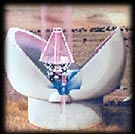 |
 |
 |
Powering your Spacecraft
How will your spacecraft power itself? It will need fuel to maneuver into position to intercept orbital debris, but it also needs electrical power to run computer systems which detect debris, calculate each new position, and control the thrusters.
NASA has typically used several methods to generate electrical power in space, and has experimented with several others as well. Which method will you use?
|
|
 Beam laser power from Earth to your spacecraft's solar panels. This method may increase the efficiency of solar panels by 200%. Read more about beampower. |
 Spacecraft powered by nuclear power such as radioisotope thermoelectric generators (RTGs) have orbited the Earth and probed deep space for over twenty years. Nuclear power supplies a constant and reliable source of electricity for many years. Read more about nuclear power. |
 Fuel Cells use chemical reactions to transform hydrogen and oxygen into electrical power, water and heat. NASA has used them in spacecraft from Gemini to the Space Shuttle. Read more about fuel cells. |
Think about how you will power your spacecraft! Then explore another briefing topic, or begin designing your spacecraft!
|
Solar panel and RTG images copyright 1996-97, California Institute of
Technology. All rights reserved. Further reproduction prohibited. Fuel cell image courtesy Schatz Energy Research Center, Humboldt State University, California. Beampower image courtesy NASA |
